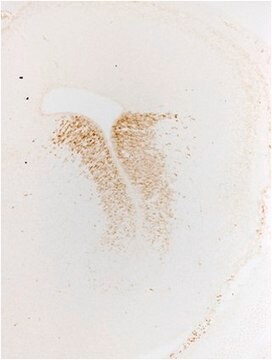AB1511
Anti-Glutamate Decarboxylase 65 & 67 Antibody
Chemicon®, from rabbit
Synonyme(s) :
65 kDa glutamic acid decarboxylase, Glutamate decarboxylase 65 kDa isoform, Glutamate decarboxylase-2 (pancreas), glutamate decarboxylase 2, glutamate decarboxylase 2 (pancreatic islets and brain,65kD), glutamate decarboxylase 2 (pancreatic islets and br
About This Item
Produits recommandés
Source biologique
rabbit
Forme d'anticorps
saturated ammonium sulfate (SAS) precipitated
Type de produit anticorps
primary antibodies
Clone
polyclonal
Espèces réactives
mouse, feline, rat, human
Fabricant/nom de marque
Chemicon®
Technique(s)
immunohistochemistry: suitable
western blot: suitable
Numéro d'accès NCBI
Numéro d'accès UniProt
Conditions d'expédition
dry ice
Modification post-traductionnelle de la cible
unmodified
Informations sur le gène
human ... GAD2(2572)
Description générale
Spécificité
Western blot reveals a doublet at approximately 65/68 kDa.
Immunohistochemical staining can be abolished by preincubation with 1-10 μg peptide (Catalog Number AG252) per mL of diluted antibody.
Immunogène
Application
1:200-1:5,000 dilution of a previous lot was used in immunohistochemistry (overnight PAP or ABC). Several fixative solutions may be used. Aldehyde-combination fixatives (i.e. those containing formaldehyde and glutaraldehyde) usually give satisfactory results. Bouin and Susa fixatives containing 0.1-0.2% glutaraldehyde have been used satisfactorily. Also reactive on paraffin embedded tissue. Protease digestion is not required.
Optimal working dilutions must be determined by the end user.
Neuroscience
Neurotransmitters & Receptors
Neuronal & Glial Markers
Qualité
Western Blot Analysis:
1:500 dilution of this antibody detected GAD 65&67 on 10 μg of mouse brain lysates.
Description de la cible
Forme physique
Stockage et stabilité
Handling Recommendations: Upon first thaw, and prior to removing the cap, centrifuge the vial and gently mix the solution. Aliquot into microcentrifuge tubes and store at -20°C. Avoid repeated freeze/thaw cycles, which may damage IgG and affect product performance.
Remarque sur l'analyse
Whole rat brain lysate, mouse brain cell extract.
Autres remarques
Informations légales
Clause de non-responsabilité
Vous ne trouvez pas le bon produit ?
Essayez notre Outil de sélection de produits.
En option
Code de la classe de stockage
12 - Non Combustible Liquids
Classe de danger pour l'eau (WGK)
WGK 1
Point d'éclair (°F)
Not applicable
Point d'éclair (°C)
Not applicable
Certificats d'analyse (COA)
Recherchez un Certificats d'analyse (COA) en saisissant le numéro de lot du produit. Les numéros de lot figurent sur l'étiquette du produit après les mots "Lot" ou "Batch".
Déjà en possession de ce produit ?
Retrouvez la documentation relative aux produits que vous avez récemment achetés dans la Bibliothèque de documents.
Notre équipe de scientifiques dispose d'une expérience dans tous les secteurs de la recherche, notamment en sciences de la vie, science des matériaux, synthèse chimique, chromatographie, analyse et dans de nombreux autres domaines..
Contacter notre Service technique








